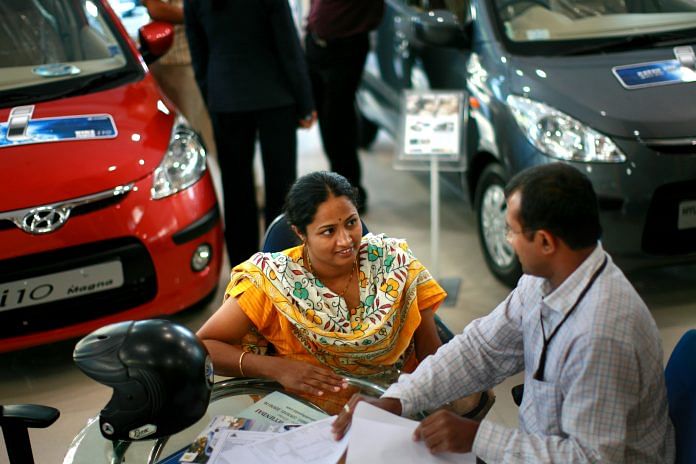The global middle class is typically defined as having daily consumption expenditure levels of above $10 (in terms of purchasing power parity), which is roughly Rs 650.
New Delhi: For India to raise the income of at least half its population to a level comparable to that of the global middle class, its economy has to sustain a growth rate of over 8 per cent for the next three decades, the World Bank has said in a report.
The global middle class is typically defined as having daily consumption expenditure levels of above $10 (in terms of purchasing power parity), which is roughly Rs 650.
After the shock of demonetisation in late 2016 and the implementation problems involving the Goods and Services Tax (GST) last year, the Indian economy has started to recover assisted by recent reforms, and growth should soon revert to 7.5 per cent. For 2017-18, the growth rate is estimated to be 6.7 per cent.
However, sustaining growth rates exceeding eight per cent would require continued reforms, and “a widening of reform scope aimed at resolving issues related to credit and investment, and enhancing the competitiveness of India’s exporting sector”, the World Bank said in the ‘India Development Update’.
India and the 8 per cent chase
India has attained a growth rate of 8 per cent only six times over the past five decades, for a total of 11 years. However, in most cases, growth acceleration lasted only one year, and itself corrected sharply in the year after.
“In some of these episodes, high growth was due to a low base impact of slow growth in the previous year followed by an unusually good agricultural output (1976, 1989); in others, it was an outcome of unsustainable fiscal or other macroeconomic policy (such as 2010-11)”, the report said.
Only during the period between 2003-04 and 2007-08 did India manage to sustain a growth rate of eight per cent for more than a year because of healthy growth in all domestic sectors accompanied by good growth in the global economy.
What does India need to do to achieve 8 per cent growth?
The World Bank’s ‘Systematic Diagnostic for India’, released a couple of months ago, listed several constraints it said were preventing India from achieving high levels of growth. The scarcity of resources puts India at a disadvantage, which is why, the World Bank said, the country should use the resources available more efficiently within every sector, and allocate them more competently.
It added that the effective utilisation of government expenditure was more important than simply increasing the spending or investment. The report also stressed the need to plug the coordination gap between various levels of the government.
“Current public spending is much less effective than it could be, suggesting an emphasis on outcomes and efficiency is warranted rather than simply spending more money on problems that require better performance by public sector service providers,” the report said.
The report also calls for increasing salaried jobs for India’s growing population by building an investment environment that is conducive to the development of high-productivity firms, nurturing trade between firms domestically and internationally, and guaranteeing firms access to affordable financing.
Why is India unable to achieve 8 per cent growth?
Doing business in India is easier than ever, public investment has picked up, and the Indian bourses are doing exceedingly well, thereby offering good valuations to companies looking to raise money, but a big hindrance comes in the form of subdued private investment.
“Going forward, de-risking the private sector may be important, as it may be to ensure an environment of policy certainty,” the report added.
Also, saddled with hefty bad loans dating back to the 2004-08 era and caught up in the aftershocks of banks’ lending frenzy to boost growth post the 2008 financial crisis, the banking sector is struggling.
“The implementation of the new Insolvency and Bankruptcy Code is an important step towards changing the credit culture,” the report said.
“However, the policy will take time to be effective in cleaning the balance sheets and ultimately changing the credit discipline in the country, and is unlikely to improve capital adequacy of banks on its own,” it added.
Among other suggestions for the sector, the report said that, apart from the recapitalisation of public sector banks, what was needed was a level playing field for private banks and opening it up for greater competition.
The export sector is another area where the report urges action. Though India’s exports have picked up of late, the growth rate has lagged behind that for world exports since the 2008 financial crisis, a fact reflected in India’s stagnant or declining share in world exports.
“Among the many preconditions for India to improve its competitiveness is an infrastructural boost to bring it on par with the current manufacturing hubs of the world,” the World Bank report said.
“In addition, reforms to land, labour and financial markets are needed to assure the continued competitive supply and use of key production inputs, such as labour, land, finance, and skills,” it added.
The report also cites the two interest rate hikes effected by the US Federal Reserve in 2017 and the three likely in 2018 to point out how higher interest rates would likely tighten finance conditions for India, adding, “Hence, enhancing competitiveness in domestic financing conditions will be even more important.”




The global middle class is typically defined as having daily consumption expenditure levels of above $10 (in terms of purchasing power parity), which is roughly Rs 650.
That is wrong. It is PPP, so that would be around Rs. 200/
65 X 10 X 1670/5350 = Rs. 203
Rupees to dollar conversion rate X $10 (PPP consumption in $) X Per capita Income Nominal ($1,670) Divided by Per capita income PPP ($5350)